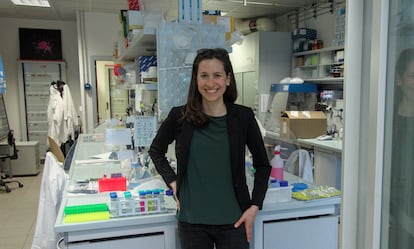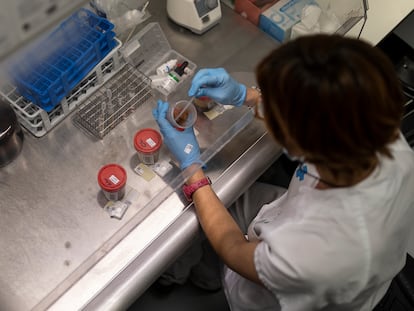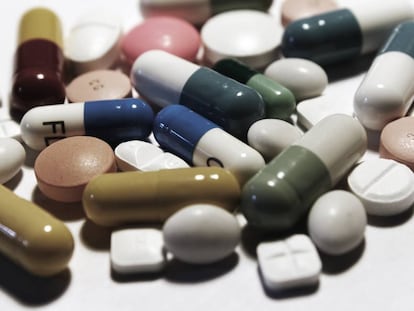Mireia Vallès-Colomer, microbiologist: ‘Without bacteria, our life is not possible’
The researcher is committed to studying how mental illness is influenced by the microbes that live in our intestines

The microbiome is on everyone’s lips. Literally. There is, in fact, a world of microorganisms that populate the oral cavity, the intestine, the vagina and so on, and perform essential functions for our organism. The scientific community knows that millions of bacteria, viruses, fungi and yeasts coexist in harmony within the body and work to support our life, but they do not know exactly how they do it, or to what extent their influence is felt.
Much remains to be discovered, admits Mireia Vallès Colomer, a microbiologist and postdoctoral researcher at the Computational Metagenomics Laboratory of the University of Trento (Italy) and expert in the study of the impact of the intestinal microbiome on health: “We have gone from completely ignoring it to it being the solution to everything. I believe that the truth is somewhere in the middle: it can help us with many diseases, but by itself it will not be the solution,” says the researcher in a videoconference interview with EL PAÍS, a few days before participating in a symposium on the microbiome organized by IrsiCaixa in Barcelona.
Vallès-Colomer, who has a master’s degree in molecular sciences and a PhD in biomedicine, has seen the meteoric rise of the microbiome as an object of study in recent years, as the eyes of the scientific community have turned to this ecosystem of microbes to find answers to dozens of diseases. She has done it too: the researcher opened a thread of connection between mental health problems and the gut microbiome by discovering that people with depression had different bacterial compositions than healthy people. Vallès-Colomer also published a study revealing that bacteria are transmitted between people through social interactions: two people living together share 12% of the strains in their intestines and up to 32% in their mouths.
Question: The study of the microbiome is everywhere, it is mentioned in scientific articles of all kinds. But it’s usually in the conditional: it could play a role in health and wellbeing. What do scientists really know about the ecosystem of microorganisms that populate the gut?
Answer: In a decade or so, the field has grown tremendously, and we have learned a lot. Our big problem is that we always have associations. In other words, they are descriptive studies: we see that if we compare people with a disease and other healthy people, there are these differences, but the difficulty is to establish causality. Alterations in the microbiome could be a cause or a consequence of the disease. Or not at all, it could be that people with this disease eat differently, and that their microbiome would change because of those differences in diet.
Q. How does the microbiome mediate health and disease?
A. We know, and this is the clearest evidence, that without bacteria our life is not possible. Inside our bodies, they help us in digestion: fibers that are super important for our health, but cannot be digested, are broken down by the bacteria we have in our intestines. They also produce vitamins, many essential micronutrients and they keep our immune system under control. They train it and, because they are there, they protect us from pathogens.
Q. What happens when a disease appears? Experts speak of a dysbiosis, an imbalance in that ecosystem, but what does that mean?
A. Dysbiosis is an alteration of the microbiome with respect to normal composition, although “normal composition” is also a very large definition because it is not the same in two healthy people. Most of the time what happens is that there is a loop: you have a microbiome with many diseases, it is less diverse, less resilient to external stimuli, and this already has a lower level of inflammation: more inflammation is created, by the immune system or, in many cases, because a pathogen arrives. And all this changes the composition of the microbiome and provides pathogenic species, which are often already there, but at super low levels and do nothing to us, with the conditions that favor their survival the most.
Q. In 2019, you participated in a study in which two genera of bacteria were identified, Coprococcus and Dialister, that were in short supply in people with depression. What does this mean?
A. This is an association: we see that these people have lower levels than the rest of the population. We wanted to see what the properties of these bacteria were and we found that many of them were producers of butyrate, which is the main source of energy for colonocytes, the cells of the intestine, and that they also lowered inflammation levels. Surely, what is happening is that these people have a more pro-inflammatory microbiome. Within a genus of bacteria there may be strains that are very different from each other and this is why we are now developing more precise methods, because perhaps the problem is not a whole genus of bacteria, but only some strains.
Q. How does the gut-brain axis work? How do they talk to each other?
A. It is important, and we are seeing several mechanisms that are related. One part is through nerve pathways, i.e. the vagus nerve: neurons that occur in the intestine and reach the brain. Another mechanism is inflammation, which is also related to cortisol, the stress hormone. And the third is the direct production of many neurotransmitters in the gut: a very large part of the serotonin, dopamine and GABA [Gamma Aminobutyric acid] in our bodies is produced in the gut, not in the brain, and there is a part that can travel to the general circulation and from there to the brain. But there are molecules that do not and yet may still have a function.
Q. Was it wrong, historically, to focus on the brain to treat mental health problems? Should one look a little lower to the gut?
A. I wouldn’t say it’s wrong or that you just have to look down, but zoom in and study the whole body, not just focus on the brain. We know that the main problem may be there, but it is not only there. And that’s related to the fact that treatments for depression don’t work well and maybe what we could do is develop therapies to improve the composition of the microbiome. In the end, what we need is more general medicine.
Q. How much does the microbiome influence mental health? What is the level of intensity of this relationship and what pathologies does it affect?
A. The intensity is very clear, and, in fact, it does not need to be at a scientific level. You know that all people, when they have episodes of anxiety, also have gastrointestinal problems. And when you eat worse for whatever reason, stress levels spike. What we are trying to understand is the mechanism.
Q. Do the hypotheses you raise for depression extend to other mental health or neurological problems, such as autism?
A. In the specific case of autism, what we are seeing is that there are many articles that are published, but with different results. And there’s a new paper on autism from last year that takes a better look at the dietary patterns of children, and they see that, actually, a lot of these disturbances can be explained by nutritional behavior. So, maybe the differences we see in the microbiome are not only due to the disease, but also because children eat differently. In other diseases, such as Parkinson’s or Alzheimer’s, there are clear patterns. For almost every disease we can think of, you come across an article that shows you that there are differences in the microbiome; but the important part is to see if they are really signs of the disease, or of the treatment, or if they are dietary patterns or something else.
Q. What is meant by a healthy microbiome if every healthy person has a different microbiome?
A. High diversity. It may be that the bacteria that are there are different between two people, but the two people are going to have a high diversity of microbes.
Q. In one of your studies you revealed that social interactions somehow shape our microbiome. Does that mean that everything sticks together, even our bacteria?
A. Yes, to a certain extent, yes. When the baby is born, it is born almost sterile and receives all its bacteria from its mother. But what we see is that babies lack many of the bacteria typical of adults, so we have to acquire them sooner or later. The new part of this year’s article is that in adults there is also a lot of sharing, and this is not a bad thing. Do I have to be more hygienic? We believe not. A more diverse microbiome is a good thing. More interaction with more people is one thing that will enrich your microbiome.
Q. How is this transfer of microbes done? Is living with one person the same as partying with 200?
A. It is important for the intestinal microbiome that the interaction be prolonged. If you run into one person at the supermarket, or many at the nightclub, you may not exchange anything. Quality social interactions are needed.
Q. If we enrich ourselves with the microorganisms of others, can we also spread dysbiosis and, therefore, non-communicable diseases can become communicable?
A.This is a hypothesis that we put forward: it could be that non-communicable diseases become communicable through the microbiome. But that is a hypothesis. We did the first study in healthy people and we saw that there is a lot of transmission. We think that, as there is diversity in healthy people, these bacteria will gain a dysbiotic community with fewer bacteria and less resistance to colonization. We don’t think it will be a problem to live with people with dysbiosis; on the contrary, it will be positive. But all this is a hypothesis because we do not yet have studies of microbial transmission in people with diseases.
Q. The microbiome is studied a lot, but there are no major effective treatments. It seems that it is not easy to manipulate or change it.
A. No, it is not easy. We believe that we have to follow a personalized medicine perspective: we cannot give just any probiotic for any alteration of the microbiome. And in the market, almost all the formulations are very similar. For probiotics, the solution is going to be something much more customized and complex. And stool transplantation is approved for Clostridioides difficile infection, but we don’t think this is the ultimate solution either: if you find a formulation of bacteria that works, it’s going to be something much more accurate than giving stools from a healthy person. Stool transplantation is being studied for more diseases and there are trials for depression, but we are still trying to understand what makes a good donor. There are still many questions and we know it is an emergency solution, not a definitive one.
Q. What should people know to take care of their microbiome?
A.The easiest part is clearly the diet, eating healthier: there are many fads here, but, in the end, eating more fiber and less processed food will help us a lot, along with an active lifestyle. And interacting with more people is also associated with a higher quality of life, greater mental health.
Sign up for our weekly newsletter to get more English-language news coverage from EL PAÍS USA Edition
Tu suscripción se está usando en otro dispositivo
¿Quieres añadir otro usuario a tu suscripción?
Si continúas leyendo en este dispositivo, no se podrá leer en el otro.
FlechaTu suscripción se está usando en otro dispositivo y solo puedes acceder a EL PAÍS desde un dispositivo a la vez.
Si quieres compartir tu cuenta, cambia tu suscripción a la modalidad Premium, así podrás añadir otro usuario. Cada uno accederá con su propia cuenta de email, lo que os permitirá personalizar vuestra experiencia en EL PAÍS.
¿Tienes una suscripción de empresa? Accede aquí para contratar más cuentas.
En el caso de no saber quién está usando tu cuenta, te recomendamos cambiar tu contraseña aquí.
Si decides continuar compartiendo tu cuenta, este mensaje se mostrará en tu dispositivo y en el de la otra persona que está usando tu cuenta de forma indefinida, afectando a tu experiencia de lectura. Puedes consultar aquí los términos y condiciones de la suscripción digital.
More information
Archived In
Últimas noticias
There is as much life left to discover on planet Earth as that which is already known
Dozens presumed dead, around 100 injured in fire at Swiss Alps bar during New Year’s celebration
Is porn for women different from conventional porn? We spoke to those who make it
Cartagena de Indias is sinking: What can the city do to mitigate it?
Most viewed
- Reinhard Genzel, Nobel laureate in physics: ‘One-minute videos will never give you the truth’
- David King, chemist: ‘There are scientists studying how to cool the planet; nobody should stop these experiments from happening’
- Oona Chaplin: ‘I told James Cameron that I was living in a treehouse and starting a permaculture project with a friend’
- Sinaloa Cartel war is taking its toll on Los Chapitos
- The Interoceanic Train, the Mexican alternative to the Panama Canal











































